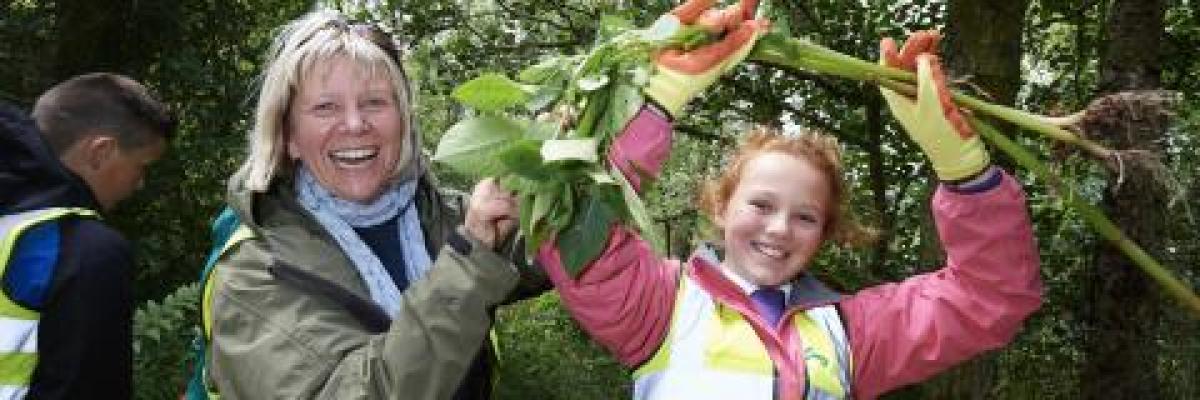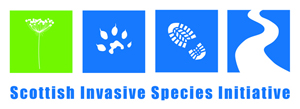Ambitious project launches to halt alien invasion

The £3.34 million Scottish Invasive Species Initiative is officially launched today by Scottish Natural Heritage with the help of pupils from Ben Wyvis primary school.
The initiative, led by Scottish Natural Heritage (SNH) and funded by The National Lottery, was set up to tackle one of the countryside’s biggest problems – invasive non-native (alien) species.
On the River Conon, it was a case of many hands make light work, as the P6 class from Ben Wyvis Primary School (Conon Bridge) gamely rolled up their sleeves and got stuck in to helping pull out the invasive Himalayan balsam plant.
Lynn McKelvey, Cromarty Firth Fishery Board Project Officer explained why the pupils help was needed; “Here at Garrie Island, in the river Conon, we have fantastic wet Alder woodland, which is designated as being important at both a UK and European level. However, the woodland habitat has been under threat from invasive species, particularly Himalayan balsam, which spreads so quickly growing in dense stands, meaning no native wildflowers can grow. In winter it dies back leaving the riverbanks bare and at risk of erosion, which can also lead to flooding problems. We did some survey work and found the source of the plant – it had escaped from someone’s garden 10km upstream! For the last 10 years we’ve had a strategic programme of control underway, gradually working downstream removing all the Himalayan balsam, but it’s a slow and thankless task, so we are grateful to the local school for coming along and helping out today.”
Head Teacher Tania Mackie commented; “Outdoor Learning is fundamental to the curriculum at Ben Wyvis Primary School, as is working with local partners. We are delighted to be working with Cromarty Firth Fishery Board and the SISI project. Not only are the children being supported by experts, but the pupils of Ben Wyvis Primary are also learning about their local environment. Learning in context is a valuable experience for all our young people and as a school we are encouraging our young people to step beyond the classroom, whilst developing the young workforce”.
Himalayan balsam is just one of the invasive species that the Scottish Invasive Species Initiative (SISI) will be tackling over the next 4 years, along with Giant hogweed, Japanese knotweed and American mink. Not only do these plants out compete native flowers and leave the riverbanks at risk of erosion, in the case of Giant hogweed they can cause serious burns on contact with skin so are a real hazard. The Initiative is also going to be controlling the invasive American mink, which had a devastating impact on the native water vole populations when it escaped into the countryside.
Project Manager, Callum Sinclair added; “Invasive non-native species are a big threat to the nature of Scotland and so it’s crucial we address the problem. They are species that have been introduced to Scotland and are spreading and causing harm to our environment, native wildlife or people.
“We can’t deal with this threat on our own, so our project is working with volunteers and local communities to put in place sustainable, long-term control for the worst offending invasive plants and the American mink. This is a really ambitious project working at a huge scale. It encompasses over a third of Scotland and the success of it hangs on the support and dedication of networks of volunteers working with us and our local fishery trust partners.
We are delighted to have the pupils of Ben Wyvis helping us - you’re never too young (or old) to care and be passionate about your local environment and these young people are making a great contribution to their river with the help of the Cromarty Firth Fishery Board team. Hopefully they can help inspire others to get involved too”
SNH Head of Policy and Advice, Eileen Stuart, joined the group to mark the official start of the SISI project. She said “Invasive non-native species are recognised as one of the biggest threats to nature worldwide, even more so than climate change. They are also having a significant impact on our economy, costing Scotland an estimated £300 million a year.
“We are delighted to see this project starting and know that by working together with local communities and schools the project will be successful in raising awareness of the problem, as well as controlling invasive non-native species, and at this scale, it will have a significant impact on improving our countryside.”
The Initiative received an award of £1.59 million from the Heritage Lottery Fund. Lucy Casot, Head of HLF in Scotland, said: “Our natural heritage is a most precious resource and, thanks to funding from The National Lottery, we have helped to protect an amazing range of Scottish landscapes, habitats, and species of plants and animals. We are proud to support the Scottish Invasive Species Initiative in their efforts to encourage people of all ages to get involved in the natural world and in doing so, conserve it for future generations to enjoy.”
